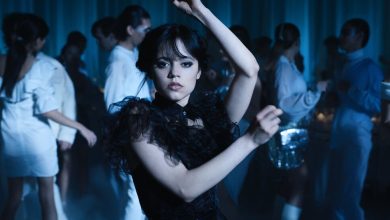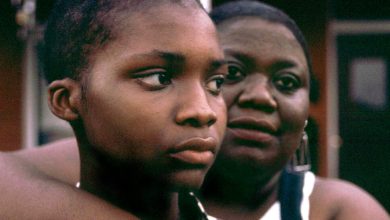Hollywood Star Gives Broadway a Much-Needed Boost. Sound Familiar?

It was as dark a time as Broadway had ever seen. Multiple stages were shuttered, uncertainty abounded, and a beleaguered theatrical season was limping along, desperate for a hit. But then a Hollywood movie star — who was also a uniquely magnetic performer on the musical stage — rode into town, bestriding a vehicle perfectly suited to his outsize talents. He had retreated to a film career for nearly a decade, and frequently hinted at a Broadway return, but then, in his 50s, he finally did so — and it didn’t hurt that a beloved musical comedy ingénue was at his side.
Consumers tossed money over the box-office transom by the sackful, creating one of the biggest box-office advances in memory. It was a triumph that prompted one critic to conclude: “Broadway is beginning to look like Broadway again.”
While this may sound an awful lot like Hugh Jackman’s highly anticipated return to Broadway in “The Music Man” (co-starring the captivating Sutton Foster), this précis also captures another Broadway comeback: Al Jolson’s star turn in “Hold On to Your Hats,” a long-forgotten show that took a forlorn town by storm 82 years ago. And, though “The Music Man” grossed $3.5 million the other week — the most of any show since theaters reopened after the long pandemic shutdown — Jolson, it should be noted, got better reviews.
By the end of the 1930s, Jolson’s eight-cylinder performance persona had been idling over in Hollywood. Although he had dominated Broadway in the late teens and the 1920s, usually in rickety vehicles that accommodated his performances in blackface, the phenomenon of talking pictures — which he had exploded with “The Jazz Singer,” the first feature-length “talkie” with musical sequences, in 1927 — had changed over the following decade.
“His kind of all-devouring star personality was no longer the kind that would thrive on film; Jolson was instrumental in creating the movie musical, but it had left him behind by then,” Richard Barrios, the musical film historian, recounted in a phone interview. His earlier films had been commercial blockbusters, showing off his ebullient and narcissistic way with a musical number, but Hollywood musicals were pivoting from such personality-pounding packages to more ensemble-driven stories and gentler stars such as Fred Astaire or Judy Garland. This transition made Jolson feel as if he was being put out to pasture on the West Coast — not to mention his fraying marriage to Warner Bros.’s tap-dancing ingénue Ruby Keeler. As the new decade began, Jolson’s primary passion was for playing the ponies out at Santa Anita Park.
And it was a pony that would carry him back to the East Coast.
The producer Alex Aarons had an idea for a stage show that would star Jack Haley, who had just starred as the Tin Man in “The Wizard of Oz.” The show’s concept was pretty clever by the standards of the day: a Western action hero for the Nationwide Broadcasting Company, named the Lone Rider (and his faithful companion, Concho — get it?), is recruited by denizens at the Sunshine Valley Rancho to defend them against bandits; they don’t realize he’s a radio entertainer playing a fictional character. The scenario provided for plenty of high jinks and heroism for the performer playing the Lone Rider, who’s “so tough, he uses a rattlesnake for a whip.” Spoiler alert: in real-life, he’s not. (This is an original concept, though, “borrowed” subsequently for such films as “Three Amigos” and “Galaxy Quest.”)
Aarons recruited the “Wizard of Oz” lyricist, Yip Harburg, and the composer Burton Lane, who was also working in Hollywood at the time, to collaborate with the “Anything Goes” writer Guy Bolton (abetted by a few errant gag men). When Haley bowed out, Jolson was immediately interested, piqued by the comic and musical potential offered by the Lone Rider character. (Jackman, of course, has his own resonance with an action hero, having played Wolverine in the “X-Men” movies.) He signed on for a fall 1940 Broadway opening of “Hold On to Your Hats” and agreed to front 80 percent of the show’s nearly $100,000 investment.
That meant Jolson was calling most of the shots, and he cannily shaped the new musical around his strengths. Thankfully, he eschewed any of his blackface routines (though, typical of its time, the show’s script embraced the casual racist stereotypes of Mexicans, Native Americans and Jews). But Jolson — for whom the fourth wall was a mere inconvenience — managed to stop the show each night, usually at its climax, to sing a medley of his popular hits. Audiences were given a vague context for such digressions — the Lone Rider was a radio entertainer, after all — and his interpolations so offended Harburg and Lane that they refused to leave Hollywood to watch Jolson’s antics once the show hit Broadway. (They would return to New York in 1947 for “Finian’s Rainbow.”)
Another of Jolson’s creative decisions was downright deranged: He offered the ingénue role to Keeler, who had just filed for divorce back in California. According to Lane, in an interview decades later, Jolson “expressed this: ‘She’s never been on the stage with me. I think that if she works with me on the stage, she’ll see how wonderful I am and she won’t want to divorce me.’” Somehow, Keeler agreed to sign on for the thankless role and off the show went to out-of-town tryouts in the summer of 1940.
“Thankless” seemed to have been the key word in the Jolson-Keeler marriage; there was a 24-year age difference between the two, and Barrios recalled a comment made by Keeler to a commentator in the 1970s: “Al was the world’s greatest entertainer. He used to tell me so every day.” Jolson’s anxiety about the incipient rapprochement got the better of him during the Chicago leg of the tryout; during their duets, Jolson would make cracks about their marriage, Keeler’s talent, Keeler’s mother. That was it. Keeler stormed off the stage, quit the show and divorced Jolson within months.
None of this mattered to the cheering throng that greeted Jolson when he sidled up to Broadway’s Shubert Theater on Sept. 14, 1940. (He had wanted his cherished Winter Garden Theater — where Jackman’s “The Music Man” is currently playing — but it was occupied by the manic comedy “Hellzapoppin.”)
“Al Jolson is back on the home grounds,” wrote John Anderson of the New York Journal-American, “in celebration whereof I toss my own critical headgear over the moon and over the dictionary.”
10 Movies to Watch This Oscar Season
“Belfast.” In this charming memoir, the director Kenneth Branagh recalls, through a rose-tinted lens and black-and-white photography, his working-class childhood in a turbulent Northern Ireland.
“CODA.” A shy 17-year-old is the lone hearing member of her rambunctious family. As she confronts a newly awakened desire to sing, her efforts to share her musical talent with her deaf relatives are remarkably affecting.
“Don’t Look Up.” Two astronomers discover a comet headed straight for Earth. When they pass along the bad news, the president of the United States has other things on her mind to pay attention to than the impending catastrophe.
“Drive My Car.” A theater director grapples with the death of his wife, as he mounts a production of “Uncle Vanya.” A chauffeur assigned by the theater company ferries him to and from work while holding back vast emotional reserves of her own.
“Dune.” In this adaptation of Frank Herbert’s science-fiction opus, the young scion of a noble family departs for a desert planet home to monstrous sandworms, enigmatic Bedouin-like inhabitants and an addictive, highly valuable resource called spice.
“King Richard.” This two-for-one superhero origin story follows young Venus and Serena Williams in their ascent in women’s tennis, as they fulfill an ambition that their father had conceived before the two were born.
“Licorice Pizza.” In Paul Thomas Anderson’s coming-of-age romance, a child performer who has hit maximum adolescent awkwardness is aging out of his professional niche. His encounter with 20-something Alana, whom he instantly falls for, gets the story’s juices going.
“Nightmare Alley.” A grifter with empty pockets and a mysterious past joins the sleazoid world of 1930s back-road carnivals. He soon begins cycling through women, including a clairvoyant whose husband once had a successful mentalist act.
“The Power of the Dog.” Phil Burbank has been playing cowboy his entire adult life, raising cattle on his family’s Montana ranch for decades. When his brother George marries a widow with a teenage son, a lifelong family dynamic is disrupted.
“West Side Story.” Steven Spielberg’s remake of one of Broadway’s most celebrated musicals — a modern take on “Romeo and Juliet” — centers on the forbidden love between Tony and Maria, who are involved with two rival street gangs in Manhattan’s West Side in the 1950s.
John Mason Brown wrote in the New York Evening Post: “Mr. Jolson’s rainbow shines as brightly as it ever did. The moment he steps onstage he catapults himself into the affections of his audience. He is his old breezy Broadway self.”
In his New York Timesreview, Brooks Atkinson reassured his readership with the opening line: “It’s all right, folks.”
“Hold On to Your Hats” became a hit for the town that sorely needed one. Sixty-nine shows debuted in the 1940-41 season, which was half the number from four years previously, the least of any season in Broadway history up to that point. The Theater Guild had almost gone bankrupt; George Gershwin had recently died and his brother, Ira, had retired; the previous two shows by Rodgers and Hart, “Too Many Girls” and “Higher and Higher,” were mediocrities; Irving Berlin had decamped to Hollywood. Across the country the effects of the Great Depression lingered, and the news from Europe was even worse.
“The year 1940 was a precarious time, the future seemed uncertain,” Jeanine Basinger, the historian and author of “The Movie Musical,” said in a phone interview. “Someone like Jolson comes along, returns to his stage roots, just the way Hugh Jackman has, and the audience doesn’t care how old they are. It’s in-person electricity, it’s ageless.
“When you’re paying your money for a star, it’s reassuring — you know what you’re going to get,” she added.
Jolson, having received the reviews of a lionized lifetime and sold-out houses every night to boot, apparently got bored with the show once it made its money back after a few months. Having proved the point that he was still relevant, he closed the show. A nine-month strike by the American Society of Composers, Authors and Publishers, which began on Jan. 1, 1941, kept all of the witty score’s potential hits off radio airwaves, and Jolson, who had a major record contract with Decca, never recorded one note from the show he brought so triumphantly to 44th Street.
“You ain’t heard nothin’ yet!” Jolson would famously exclaim when the audience would beg for more — and then keep performing, way past the stagehands’ overtime call. After corralling a hit for a desperate Broadway, Jolson, having “nothin’” left to say or sing, rode back into the California sunset, passing the torch to other Hollywood stars and their own rescue missions along the Broadway trail.
Laurence Maslon is an arts professor at New York University and the host of the NPR program, “Broadway to Main Street.”





